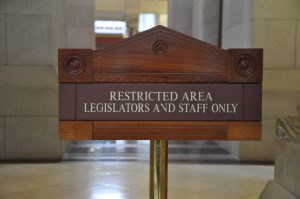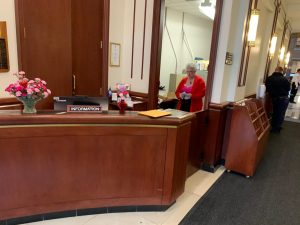Navigating the Capitol and Legislative Office Building
Connecticut’s State Capitol and Legislative Office Building are now fully open to the public.
Directions to the Capitol and Legislative Office Building (LOB)
Aerial view of Capitol and LOB with public entrances
The Capitol building’s address is 210 Capitol Avenue, Hartford and the Legislative Office Building is at 300 Capitol Avenue, Hartford.
Before you go
Before you go, check to see if the Connecticut Network (CTN) will be broadcasting the meeting you are interested in. The meeting you want may be televised so you can track what’s happening without making the trek to the Capitol.
How to know what’s going on in the building. When you get to the LOB, there are screens throughout both buildings with the day’s schedule scrolling, including times and locations.
Before you go, read the Bulletin for the day to know where you’re going and when. Each day during the legislative session and weekly off-session, a new Bulletin is published. The Bulletin has the schedules for that day and into the future, agendas for public hearings and committee meetings, when they will go into session, any other events (press conferences, group meetings, etc.) and the rules of the place.
The Bulletin is extremely helpful if you are testifying at a public hearing listing which bills are being “heard” that day, the sign up process to testify in person, where to email written testimony, how many paper copies you’ll need if you go, and where to bring them.
It includes a helpful list of offices, addresses and phone numbers, security measures, and public services available. It may also include a list of legislators each committee.
Logistics
It’s best to get there early, especially during the legislative session. If you arrive early you have a better chance of getting a spot in the legislative garage and you’ll have time to orient yourself before any meetings or hearings.
What to wear: Wear non-slippery, comfortable shoes. You will do a lot of walking and the stairs in the Capitol can be slippery. As for dress, there is a wide range, you certainly don’t have to wear a suit (although you wouldn’t be out of place) but dress professionally. It is best to wear something comfortable.
Parking –There is free parking in the Legislative Garage just beyond the entrance to the LOB. Turn right at the garage stop sign. On session days there may be a Capitol police car parked near the entrance. You can park on the first floor. Some spaces are reserved for people with disabilities, electric cars for charging, and for compact cars.
If you circle the first floor and all the spaces are full, go back out to the stop sign, turn right and follow the road down to the back entrance on the right. Go very slowly through the gate, turn right to the end of the row and turn left by the bright blue wall. Be careful as it is a tight fit. You will then enter into the underground garage. You can park in any of the spaces.
If the underground spaces are also full, go back out to Capitol Avenue. There are paid lots in the area and there may be free parking on the streets around the LOB.
LOB Entry and Security: Enter the LOB through the first floor revolving doors on the western end. You must pass through metal detectors to enter the LOB or the Capitol. There can be a line so leave extra time. If you aren’t sure if you’re allowed to do something, ask the Capitol Police.
Services
Food and drink: The cafeteria is on the first floor of the LOB – enter down a little hall to the right of the elevators. The cafeteria offers coffee, snacks, sandwiches, pasta, a grill, and salad bar. The cafeteria opens at 7:00 am and closes at 3:00pm, 4:00pm during session. There is a smaller counter with food and drinks on the second floor of the LOB on the Capitol side. There is a Newsstand with snacks, aspirin, newspapers, etc. on the first floor of the LOB on the hall toward the Capitol passage. There are snack and drink machines in the hall behind the stairs on the first floor of the LOB and in the basement of the Capitol. At lunchtime, there are carts offering food on Elm Street near the park.
ATM machine: There is an ATM machine on the first floor of the LOB, on the right as you walk from the LOB toward the Capitol through the underground concourse.
Quiet places to sit: This can be very important to a good visit – there is a lot of waiting around at the Capitol and LOB. You can sit in the cafeteria (it is best if you buy something), in the “break out area” on the western end of second floor of the LOB by the big windows, on the soft chairs on the eastern end of the second floor of the LOB by the snack counter, on benches in the center of the LOB lobby, in empty (or full) hearing rooms, on benches throughout the Capitol and in other rooms throughout the complex.
Restrooms: In the LOB, there are restrooms to the left of the elevators on the first floor, down the hall to the right of the elevators on the second floor, and several others in somewhat hidden places. Ask anyone.
In the Capitol, there are restrooms on the North side of the building on the first, second and third floors.
Between the LOB and Capitol: You can travel between the LOB and the Capitol by the underground Concourse (kids love the people-mover). Enter the Concourse from eastern end of the first floor of the LOB (past the store and the ATM machine).
Information desk: There is an information desk, manned by the Connecticut League of Women Voters, by the revolving doors at the western end of the LOB first floor. The staff at the desk are very helpful. That desk is also where you can find out about tours of the Capitol – a great idea, if this is your first time.
Rules and tips
Velvet ropes and galleries: To watch the House or Senate in session, you can go to their respective galleries. The House Gallery is on the south side of the fourth floor of the Capitol. The Senate has two galleries (depending on which side of the Senate circle you want to watch) – both are on the north side of the fifth floor. If you want to talk to a legislator, you should text them, talk to their aide, or wait outside the chambers for them to walk by. You can send a note to a House member through the staff at the desk by the phone booths to the right of the chamber. Use this resource sparingly. There are velvet-roped areas that registered lobbyists must stay behind. As a non-lobbyist member of the public, a legislator may invite you to accompany them to seats within the chamber. In the Senate, you’ll sit in chairs behind them; in the House, on benches in the “well of the House”. It’s kind of cool for the first ten minutes or so.
To access legislative language and documents on-site: Bring your favorite electronic device. The public wi-fi network is CGA Guest.
Lobbyists: Registered lobbyists have extra rules for working within the LOB and Capitol. They must wear badges that identify them and cannot go beyond the velvet ropes to talk with legislators (see above). However, they have a vast store of knowledge in how the building and the system works – both the process of passing (or killing) legislation, and the logistics of the place. Connecting with one for advice can be invaluable.
Cell phones: Cell/smart phones are a critical piece of staying in touch while working in the LOB and Capitol. However, you cannot use them in hearing rooms or galleries. Either turn them off or set them to silent mode. Texting is the main way of communicating in the LOB. Take any conversations – by phone or in person -- outside the hearing room.
How to connect with a legislator: First, find their aide and let them know that you’d like to speak with the legislator. You can find the aides by going to the Caucus offices in the LOB. For Senate Democrats and Republicans, the offices are in the northwest and southwest corners, respectively, of the third floor of the LOB. For House Republicans and Democrats, the offices are in the southwest and northwest corners of the fourth floor. Leave a note if you miss someone; include your contact information, cell phone number, and a fact sheet or letter if you have one.
Legislative library: A phenomenal resource to the right of the stairs on the fifth floor of the LOB. This is where legislative staff go first for information and research. The library has many journals and the librarians are among the most helpful people inside or outside the legislature. After the session, the library has summaries of legislation that passed each year. The library is also one of my favorite quiet places to sit.
Coming to a public hearing or a committee or task force or council meeting:
For a public hearing, come early to sign up and bring copies of your written testimony. Usually the sign up for speakers is outside the room where the hearing will be held, you can ask in the Committee room or, if it’s too early, ask people in line. You need to sign up on the public list (not the state official list, which is shorter and they go first. It’s not fair but it is the rule.)
In the hearing room, you must turn off your cell phone or turn it to silent mode. You’re not supposed to bring food or drink into the hearing rooms. Take any loud or long conversations into the hall. You cannot speak up at a hearing or committee meeting (this will be obvious when you get there). Only the legislators and members of committees, councils or task forces can ask questions.
If you have been invited to serve on a commission, council or task force, talk to the staff person (usually sitting at a desk just outside the circle near the front of the room) to ask where you should sit, get your name card, and materials. You get to sit in the cushy chairs and ask questions of speakers and other members. It is best to sit and watch for a while in your first meeting, to see how the group works. When you do speak up, you must push the button below the speaker in front of you to be heard by other members, staff (for the minutes) and for the TV cameras. Be sure to turn it off when you are done speaking – for many reasons.
The best advice is to ask questions, wait and see what everyone else does, and follow a more experienced advocate or lobbyist. Good luck.
Related articles
Importance of legislative staff
Links
Connecticut Network -- CTN-- Video of many legislative and administrative meetings and hearings – in real time and archived



